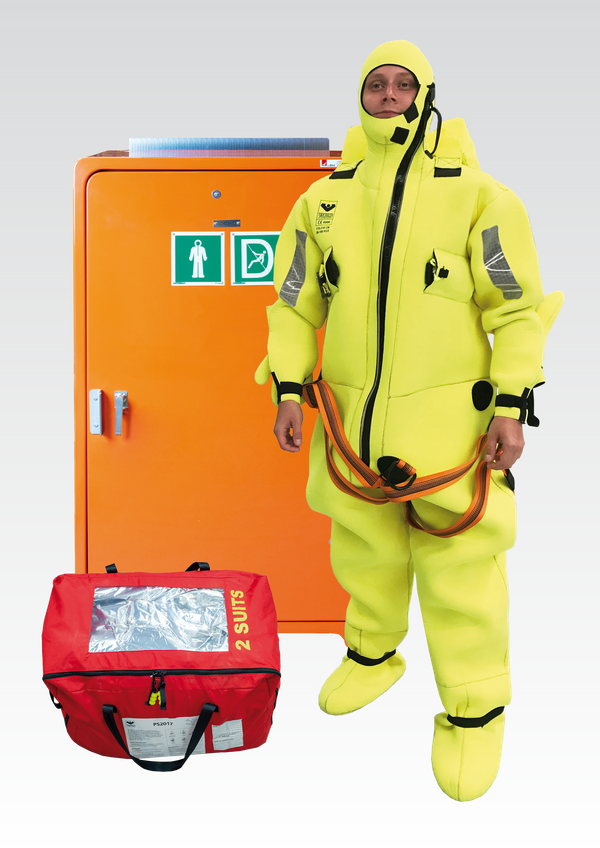
Quickly growing turbine numbers, installed in deeper waters offshore and farther out to sea are needed to serve accelerating demand for wind energy, but safety issues for such structures go beyond the feats of civil engineering making them possible.
Supervised remotely, all of these offshore assets nonetheless need periodic physical inspection and maintenance, with the engineers landing on remote platforms either from helicopters or via gangways connecting to vessels in motion. Furthermore, once landed, much of the work takes place in or on the raised nacelle: a fire in any part of the turbine’s drive train can cut off the evacuation route through the tower’s interior.
“The issue was laid bare when two young technicians died in a fire on a smaller Vestas turbine in the Netherlands in 2013,and it’s fair to say that higher towers since have also increased the scale of the challenge,” says Bettina Kjergaard, Global Product Manager, Offshore Wind, VIKING Life-Saving Equipment.
In an offshore wind industry whose capacity the International Renewables Energy Agency has predicted will grow ten-fold by 2050 (from 4.5GW in 208 to 45GW), stakeholders should be working collaboratively to ensure best practice on safety, she emphasizes.
In fact, VIKING has been working through the issues over for three years with a leading but undisclosed offshore wind player, and is now ready to bring the results to market, Kjergaard says.
Towering safety issue
“When technicians land on the tower platform (TP) at the bottom of the tower, the convention is to take off their immersion suits and lifejackets and only keep their harnesses on to climb to the top. It’s widely recognised that this is far from satisfactory from the safety perspective. Some operators provide extra gear and store it at the top of the tower. However, a technician needing to don a suit, lifejacket, harness, belt and headlamp in an emergency as separate items loses critical seconds.”
VIKING’s contribution is the new all-on-one VIKING YouSafe Hightide suit featuring rescue harnesses, gloves and descent device robust enough to support an outside descent and the built-in buoyancy so that a person in distress can stay in the water until rescuers arrive.
Made so that the user loses no more than 2oC of core body temperature in the water over a six-hour period, the suit can also be donned in a single operation and its harness hooks connected to the platform to lower himself/herself from the platform. The solution can be used to lower two people at a time, and is even fully viable for lowering personnel who are unconscious.
Kit assembly
Kjærgaard says that collaborative working had proved critical in bringing a wind turbine-specific evacuation kit to market. Skylotec, specialists in working at height solutions, for example, helped by delivering a solution to attach harness and suit using a loop arrangement attached to the suit and supplying a specially developed descent device unit that fits in the kit.
Also part of the project is a new lightweight cabinet using Lloyds approved composites including UV resistant gelcoats from UK supplier JoBird to store the equipment on the helicopter platform on top of the nacelle which can withstand 100 mph winds for 30 years. This is backed up with an excellent IP rating of 56. It has both Lloyds and ABS approvals. A 10MW turbine would feature storage capacity for eight sets of suits, harnesses, descent devices and headlamps. EMG developed a special lifting sling for the cabinet that can lift it all the way to the top of the nacelle.
Already, the VIKING YouSafe Hightide suit is ISO and SOLAS approved. Kjergaard says that deliveries for the first of thousands of new suits will start before the end of Q1 2021 to wind farms off the U.K., Denmark, Germany and the Netherlands.
Longer service interval
Following extensive testing by Force Technology, the new generation evacuation suit has also become the first lifesaving equipment kit of this type to secure an extended service interval approval. Where equipment today has a service interval of five years, the extended lifespan aligns with an industry increasing the number of assets farther out to sea, where site visits are costly and remote inspections look likely to grow in popularity, she says.
Approval of the longer service interval is once again the result of a collaborative effort. “Our light supplier worked closely with the battery supplier to secure batteries with a 20-year stock lifetime, which allowed Force Technology to sign off on the SOLAS extended service interval approval.”
Given the time and R&D investment made in the VIKING YouSafe Hightide suit, it is no surprise that VIKING has a number of variations up its sleeve. Among them is an extended service interval version of the suits it already offers for smaller turbines, while another is a VIKING YouSafe Walk to Work version which is stowed in a small pack attaching to the back of a lifejacket.
“Offshore wind safety equipment needs to be purpose-built but it also needs to be ready-to-wear and functional for personnel operating in risky situations,” says Kjærgaard “It’s an industry which has successfully transitioned from market niche to market segment and now demands a total evacuation solution with kits including a SOLAS-approved immersion suit with an extended service interval featuring integrated buoyancy and harness to allow for quick donning and instant evacuation.”